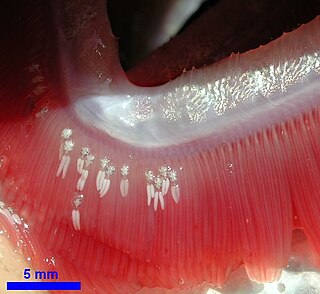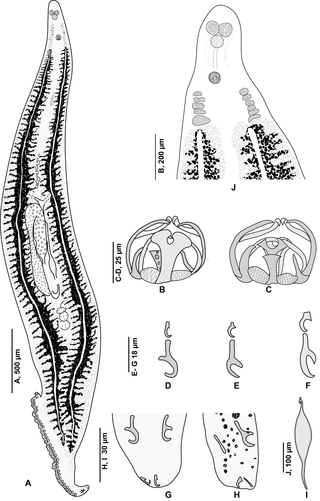
Alexander von Nordmann was a 19th-century Finnish biologist, who contributed to zoology, parasitology, botany and paleontology.

Ergasilidae is a widespread family of copepods and comprises many species. The type genus is Ergasilus. With a few doubtful exceptions all ergasilids are parasitic on fishes.

Diplozoon paradoxum is a flatworm (platyhelminth) from the class Monogenea. It is found in freshwater fishes in Asia and Europe and known for its complete monogamy. This parasite is commonly found on the gills of European cyprinid fishes. It is usually around 0.7 centimeters long and has bilateral symmetry. It has several hooks at its mouth which it uses to grab on to the gills of a fish. From there it feeds on the blood of the cyprinid.

Polyopisthocotylea is a subclass of parasitic flatworms in the class Monogenea.

Gyrodactylus is a genus of parasitic flatworms in the family Gyrodactylidae.
Dactylogyridae is a family of monogenean flatworms.

The Diplectanidae are a family of monopisthocotylean monogeneans. They are all parasitic on the gills of fish. Diplectanids are small animals, generally around 1 mm in length. As parasites, they can be extremely numerous, up to several thousand on an individual fish.
Alexandr Vladimirovich Gussev, sometimes spelled Gusev in the literature, was a Russian helminthologist specialist of monogeneans.

Boris Yevseyevich Bychowsky was a Soviet scientist and parasitologist, specialist of fish parasites, especially monogeneans. He was director of the Institute of Zoology of the Academy of Sciences of the Soviet Union in Leningrad (1962–1974). Bychowsky is the author of more than 100 scientific publications, mostly on systematics of monogeneans. His most famous work was his monography on monogeneans (1957), which was translated into English in 1961.
Hexabothriidae is a family of monogenean parasites. The family name was proposed by Emmett W. Price in 1942. The family includes 14-16 genera according to authors and about 60 species; all are parasitic on the gills of chondrichthyan fishes.

Gastrocotylidae is a family of polyopisthocotylean monogeneans. All the species in this family are parasitic on fish.

Microcotylidae is a family of polyopisthocotylean monogeneans. All the species in this family are parasitic on fish.

Allodiscocotylidae is a family of monogeneans within the order Mazocraeidea, containing 6 genera. Members of this family primarily host species of fish, such as Allodiscocotyla chorinemi hosting Scomberoides lysan.

Paradiplozoon is a genus of polyopisthocotylean monogeneans, included in the family Diplozoidae.
Actinocleidus is a genus of monogeneans belonging to the family Ancyrocephalidae. All members of the genus are parasitic on fish.
Lobotrema is a genus of monopisthocotylean monogeneans, belonging to the family Diplectanidae. All its species are parasites on fish. The type-species is Lobotrema madrasiTripathi, 1959.
Paradiplectanum is a genus of monopisthocotylean monogeneans in the family Diplectanidae. All its species are parasites on marine perciform fishes of the family Sillaginidae.
Pseudodiplectanum is a genus of monopisthocotylean monogeneans, belonging to the family Diplectanidae. Species of Pseudodiplectanum are parasites of marine teleost fish.

Pseudaxine is a genus which belongs to the phylum Platyhelminthes and class Monogenea; all its species are parasites of fish.

Diplozoon is a genus of flatworms belonging to the family Diplozoidae.












